Wolgast
Wolgast (German pronunciation: [ˈvɔlˌɡast] ⓘ) is a town in the district of Vorpommern-Greifswald, in Mecklenburg-Vorpommern, Germany. It is situated on the bank of the river (or strait) Peenestrom, vis-a-vis the island of Usedom on the Baltic coast that can be accessed by road and railway via a movable bascule bridge (Blaues Wunder). In December 2004, the town had a population of 12,725.
Wolgast | |
|---|---|
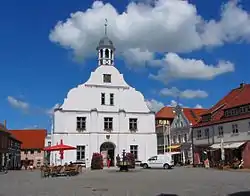 Old town hall of Wolgast | |
 Flag  Coat of arms | |
Location of Wolgast within Vorpommern-Greifswald district 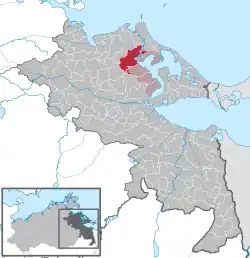 | |
 Wolgast 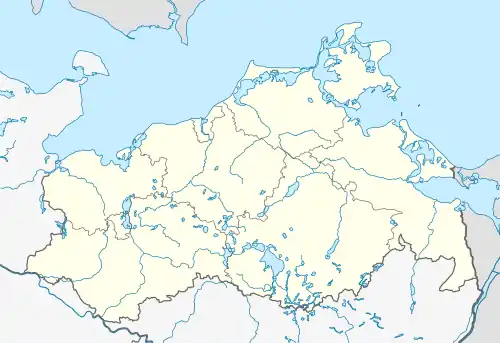 Wolgast | |
| Coordinates: 54°03′N 13°46′E | |
| Country | Germany |
| State | Mecklenburg-Vorpommern |
| District | Vorpommern-Greifswald |
| Municipal assoc. | Am Peenestrom |
| Government | |
| • Mayor | Stefan Weigler (Ind.) |
| Area | |
| • Total | 61.53 km2 (23.76 sq mi) |
| Elevation | 5 m (16 ft) |
| Population (2021-12-31)[1] | |
| • Total | 11,890 |
| • Density | 190/km2 (500/sq mi) |
| Time zone | UTC+01:00 (CET) |
| • Summer (DST) | UTC+02:00 (CEST) |
| Postal codes | 17438 |
| Dialling codes | 03836 |
| Vehicle registration | VG, WLG |
History

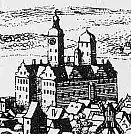
The precursor of present-day Wolgast was a Slavic Wendish stronghold located on an island within the Peenestrom sound.[2]: 159 Contemporary sources called it Hologost(a), Ologost, Woligost, Woligast, Wologost, Wolegast, Wolegust, Walagost(um), Walogost(um), Waløgost(um), Waloguslum, Walagust, Walegusth, Walægust, Walgust, Wolgast, Valagust, Wołogoszcz or Valegust.[3] Wilhelm Ferdinand Gadebusch traces the name through Wendish to mean a "large grove".[4] It is unclear which of the tribes documented in the area the population belonged to, the Veleti/Lutici or Rani.[5] In 1123/24, prince Henry of the Obodrites used the stronghold as a stepping stone in his campaign against the Rani.[6]
In 1128, after the Pomeranian duke Wartislaw I had subdued the area, the Wends were baptized by Otto of Bamberg on his second Pomeranian mission, while Wartislaw was also present in the stronghold. During this time, there was an influx of thousands of Low German settlers from Groningen and Drenthe.[2]: 152, 160 In this context, Wolgast was described as a opulentissima civitas by the chronicler Ebo, it is however unclear whether this should be read as meaning opulent or mighty "castle" or "town".[2]: 157–158 Otto destroyed a local temple devoted to Gerowit, a god of war, and replaced it with a church.[7][2]: 158 The thesis that this first church was a predecessor of today's St. Peter's church has not yet been confirmed.[2]: 158
Wolgast was made the seat of a Pomeranian castellany,[2]: 159 and played an important role in the 12th-century warfare between Pomeranians, Rani and the Danes.[2]: 158 In 1162, Wolgast was targeted by an allied Danish-Rani fleet, and temporarily had to accept Danish suzerainty.[8]: 23–25 In 1164, in the context of the battle of Verchen, a Danish force under Wetheman took control of Wolgast, and left it to a mixed Rani-Pomeranian-Obrodite garrison after peace was restored.[9][10] Yet, the Rani (the Danish allies) were soon expelled by the Pomeranians, and the Obodrites (also Danish allies) left the scene.[8]: 26 The Danes attacked Wolgast again in the summer of 1167, and again either in late 1167 or in 1168, and devastated the area.[8]: 27–28 In 1177, another Danish assault on Wolgast failed, but a campaign in 1179 was successful, though the Danish fleet accepted money instead of a surrender.[8]: 41 In 1184, Wolgast was unsuccessfully besieged by the Danes, but finally came under Danish control in 1185 when the Pomeranian duke accepted Danish suzerainty.[8]: 44–45 While the Danes lost control over most of Pomerania in 1227, Wolgast remained a Danish bridgehead until either 1241/43 or 1250.[8]: 48
On the mainland opposite to island with the castle, a new planned town was built in the course of the Ostsiedlung.[11] It is not known when exactly this city of Wolgast was granted German town law, though its existence is confirmed by a letter written in or before 1259.[2]: 160 The original charter was issued by both Pomeranian dukes of the time, Wartislaw III and Barnim I, and a confirmation of the Lübeck law was issued in 1282 by duke Bogislaw IV.[2]: 160–161
Wolgast was residence of the Pomeranian dukes from 1285 until the ruling House of Pomerania became extinct in 1637.[12] Capital of Pomerania-Wolgast, a longtime inner partition of the duchy, Wolgast Castle was built as a residential palace in Renaissance style on an island hence called Castle Island.[13] The ducal line of Pomerania-Wolgast became extinct when Philipp Julius died without issue.[14]
During the Thirty Years' War, the Swedish Empire occupied Wolgast in 1630 and kept it as a part of Swedish Pomerania until 1815. Between the 1670s to 1720s, hundreds of male residents enlisted in the VOC and emigrated to South Africa. The former ducal palace decayed, and the town was burned down in 1713 by Russian forces during the Great Northern War, in retaliation for Swedish arson in Altona.[12] Only the church, four chapels and four more buildings were spared by the fire.[12] Most houses of the Old Town therefore date back to the 18th and 19th centuries,[13] the townhall was renewed after the fire in baroque style.[12]
After the Swedish withdrawal from Pomerania in 1815, the city was integrated into the Prussian Province of Pomerania. Last remnants of the palace were removed in 1849.[13] Wolgast prospered throughout the 19th century as a port for grain trade.[12] In 1910 a Catholic Church was built for Polish workers [15]
Wolgast lost its status as a Kreis capital on 12 June 1994, when Kreis Wolgast was merged into Kreis Ostvorpommern, which became part of Vorpommern-Greifswald in 2011.
Museums
The town's history is presented in the Stadtgeschichtliches Museum (Towns' historical museum) in a building at the market place nicknamed Kaffeemühle (coffee grinder).[13] The former house of painter Philipp Otto Runge is also a museum by now (Rungemuseum).[13]
Notable people
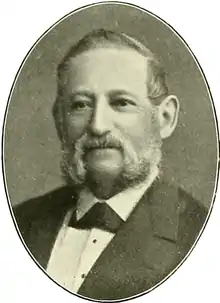

- Barnim VII, Duke of Pomerania (1390–1450) Duke of Pomerania
- Ernst Ludwig, Duke of Pomerania (1545–1592) duke of Pomerania
- Barnim X, Duke of Pomerania (1549–1603) a duke of Pomerania
- Casimir VI, Duke of Pomerania (1557–1605) a non-reigning duke of Pomerania
- Philipp Julius, Duke of Pomerania (1584–1625) duke of Pomerania
- Otto Wolgast (1640-1681) early settler in Delaware, United States and founder of the Zwaanendael Colony
- Johann Philipp Palthen (1672–1710) a Western Pomeranian historian and philologist
- Philipp Otto Runge (1777–1810) a Romantic German painter and draughtsman
- Karl Gustav Homeyer (1795–1874) a German jurist.[16]
- Adolf Friedrich Stenzler (1807–1887) a German Indologist
- Theodor Marsson (1816–1892) a German pharmacist and botanist
- Willy Stöwer (1864–1931) a German artist, illustrator and author
- Hans-Ulrich Grapenthin (born 1943) a German former footballer who played 308 games for FC Carl Zeiss Jena
- Axel Kruse (born 1967) a former German association footballer and American football player.
- Franka Dietzsch (born 1968) a former German discus thrower
- Johannes Sellin (born 1990) a German handball player
References
- "Bevölkerungsstand der Kreise, Ämter und Gemeinden 2021" (XLS) (in German). Statistisches Amt Mecklenburg-Vorpommern. 2022.
- Schmidt, Roderich (22009): Das historische Pommern, Cologne
- Prüf. Vita: Ologost; Ebo III.7: Hologost; Herbord II.39, III.4–6: Hologosta; Helmold I.38: Woligost, Woligast; 1140 papal bull: Wologost; Scandinavian sources: Walagostum, Walogostum, Waløgostum, Waloguslum, Walagust, Walegusth, Walægust, Walgust, Wolgast, Wolegust, Valagust, Valegust
- Wilhelm Ferdinand Gadebusch: Chronik der Insel Usedom. W. Dietze, Anklam 1863, S. 243 (Digitalisat)
- Ruchhöft, Fred (2001): Die Grenzen der sächsischen Marken im Gebiet der Ostseeslawen im 10. und 11. Jahrhundert (Baltische Studien NF 87), pp. 7–23, esp. 19 ff.
- Niemeck, Andreas (2002): Die Zisterzienserklöster Neuenkamp und Hiddensee im Mittelalter, Cologne, p. 12; Helmold I.38.
- "Slawische Religion" in TRE XXXI (2000), p. 398; Ebo III.5 ff.; Herbord III.4 f.
- Riis, Thomas (2003): Das mittelalterliche dänische Ostseeimperium (Studien zur Geschichte des Ostseeraumes IV), Odense
- Büttner, Bengt (2007): Die Pfarreien der Insel Rügen (Veröffentlichungen der Historischen Kommission für Pommern V 42), Cologne, pp. 33–34.
- Janus Møller Jensen (2004), "Denmark and the Holy War: A Redefinition of a Traditional Pattern of Conflict in the Baltic in the Twelfth Century", in Jon Adams; Kathy Holman (eds.), Scandinavia and Europe, 800–1350: Contact, Conflict and Coexistence, Brepols, p. 229.
- Müller-Mertens, Eckhard (1999): Stadtgründungen ... in Riis et al.: Stadtwerdung und städtische Typologie des Ostseegebietes bis zur Mitte des 18. Jahrhunderts (Studien zur Geschichte des Ostseeraumes III), Odense, pp. 113–150; esp. 121.
- Berger (2008), p. 361
- Dubilski (2003), p. 173
- Wolgast (1995), p. 217
- "Herz Jesu Kirche (Kath.)".
- . Encyclopædia Britannica. Vol. XII (9th ed.). 1881.
Bibliography
- Dubilski, Petra (2003). Die Ostseeküste : Mecklenburg-Vorpommern (in German) (2 ed.). DuMont. ISBN 3-7701-5926-8.
- Wolgast, Eike (1995). Hochstift und Reformation: Studien zur Geschichte der Reichskirche zwischen 1517 und 1648 (in German). F. Steiner. ISBN 3-515-06526-1.
- Berger, Christine (2008). Mecklenburg-Vorpommern (in German) (7 ed.). Baedeker. ISBN 978-3-8297-1062-6.
External links
- . Encyclopædia Britannica. Vol. 28 (11th ed.). 1911. p. 776.
- Wolgast depiction in 1614 by Eilhard Lubinus